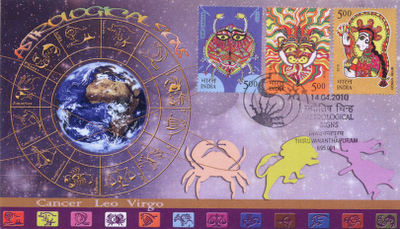This miniature sheet was issued on March 3, 2010. This set of stamps feature two beautiful Canadian African Violet hybrids in full bloom: ‘Picasso’ and ‘Deceelles’ Avalanche.’ Both plants were grown by members of the Société des Saintpaulia de Montréal (SSM). Picasso is a heavy bloomer with double flowers that are violet above and white below. Decelles’ Avalanche has semi-double red-fuchsia star blooms.
Friday, April 30, 2010
Tuesday, April 20, 2010
Sunday, April 18, 2010
Saturday, April 17, 2010
The Silent Valley
The Silent Valley
The Silent Valley, situated in South Western Ghats, is one among the world's ten "Hottest Biodiversity Hot Spots" and is believed to be the sole surviving bit of virgin tropical rain forests in this country. Located about 80 km north east of Palakkad, Kerala, India It was declared a National Park on 14'" November 1984 and now it forms part of the core of Nilgiris Biosphere Reserve.
The evolutionary age of Silent Valley, the evergreen rain forests, is believed to be more than 50 million years. This is a cliff forest cut off on all sides by steep ridges and escarpments. The topographic isolation of Silent Valley has prevented human habitation, allowing the forest to remain untouched and to emerge as an ecological oasis, preserving the flora and fauna. It is not clear who named it the "Silent Valley". It is believed that the name owes its origin to the relative absence of the cicadas which normally provide a distinctive sound in the forest environment.
The flora of the Valley includes about 1000 species of flowering plants, 107 species of orchids, 100 species of ferns and fern allies, 200 liverworts, 75 lichens and about 200 algae.
This valley is home, to 23 mammalian species including three endangered ones: the tiger, the lion tailed macaque and the Nilgiri langur. Other than the elephant, lion tailed macaque, Nilgiri langur, common langur, Nilgiri tahr, tiger, leopard, sloth bear, Gaur, wild dog, etc., The Silent Valley is home to birds, reptiles, amphibians, fishes and insects.
The Silent Valley Hydroelectric Project (SVHP) was established during 1977-80, which was submerged 830 hectares of forest. The struggle that followed to preserve the forest was perhaps one of the most successful stories of protection of the environment, capturing the imagination of writers, artists, scientists, politicians, nongovernmental organisations, media and the public alike.
Friday, April 16, 2010
Taj Mahal
Taj Mahal
Taj Mahal stands in the city of Agra, on the banks of the Yamuna river, built by Mughal emperor Shah Jahan in memory of his favorite wife, Mumtaz Mahal. Muntaz was married at 21, but in 1631, she died at the age of 39, at Burhanpur.
The construction of the Taj Mahal started in 1632, and was completed by 1654 AD. Tavernier,an eminent traveler and historian of those times, records that over 20,000 workmen laboured for 22 years to complete the Taj Mahal. Material for its construction was brought from all over India and Asia. In all 28 types of precious and semi precious stones were inlaid into white marble to create this wonder of the world.
The Taj Mahal complex comprises of five main elements: the Darwaza or main gateway, the Bagicha or garden, the Mosque, the Naqqarkhana or rest house, and Ihe Rauza or Mausoleum. The central dome, which is 187 feet high, is surrounded by four minarets. The mosque is to the left of the monument. The architecture combines elements and styles of Persian, Central Asian, and Islamic architecture. Ustad Ahmed Lahori was the Chief Architect, Ismail Khan Afridi of Turkey was the dome-maker, and Amanat Khan Shirazi was the calligrapher whose genius lives on through the enduring beauty they created.
The colours change with the hours and the seasons. Pinkish in the morning, milky white in the evening, and golden when the moon shines. It is said that these changes depict the different moods of woman.
For centuries, it has inspired poets, painters and musicians to try and capture its elusive magic in word, colour and song. It stands as an ultimate memorial to love and remains incomparable.
Wednesday, April 14, 2010
Golden Voices of Yesteryears
Golden Voices of Yesteryears
Kishore Kumar (Bengali, 1929 – 13 October 1987), was an Indian film playback singer and actor, composer and director. He was one of the leading singers in the Hindi film music industry between 1969 and 1987. He also achieved notable success as a lyricist, composer, producer, director, screenwriter and scriptwriter. He sang in many Indian languages including Bengali, Hindi, Marathi, Assamese, Gujarati, Kannada, Bhojpuri, Malayalam and Oriya. He was honoured with several awards, including eight Film fare awards.
Mukesh ( Mukesh Chand Mathur) (1923-1976), with his mellifluous voice, captured the imagination of not just the Indian audience, but music lovers in many other parts of the world. He also sang Ghazals. His first song was “dil hi bujha hua ho to” as an actor singer for Nirdosh. He received the National award in 1974 for the best play back singer for his song “Kai baor yun bhi dekha hai” in the film Rajnigandha
Mohammed Rafi (1924-1980) was one of India's greatest playback singers, whose career spanned four decades. During his long career, he performed an estimated 26,000 songs in many Indian languages including Hindi, Urdu, Bhojpuri, Punjabi, Bengali, Marathi, Sindhi, Kannada, Gujarati, Maghi, Mathili, Konkani and Telugu. He was effective in every type of singing including 'Bhajjans' and 'Qawwalies'. He also recorded a few English and Persian songs. He is primarily remembered, however, for his Hindi-Urdu songs. Rafi was one of the leading male singers in the Hindi film music industry, and won several awards including Padma Shri and 5 National Awards.
Tuesday, April 13, 2010
Subscribe to:
Posts (Atom)


























